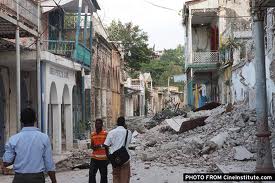CSMS Magazine Staff Writer
Who would believe it? A year has already gone by and it looks as if the tragedy took place yesterday. The level of suffering, its consistency, its raw ugliness, its everlasting aftershocks leave us in outright stupefaction. A year later, Haiti still lies in ruins. Its children continue to wallow in abject poverty, and the psychological scars sprang from the aftermath of the earthquake lives on with no signs of subsiding.
Who can forget the desperate faces of the survivals roaming aimlessly along the leveled streets of Port-au-Prince, the thousands trapped under concrete buildings? The most shocking of all was the dumping of thousands of dead bodies in shallow mass graves on the outskirts of the Haitian capital, Port-au-Prince. The scene was so shocking that the day after the quake, the world rose to its feet in indignation. A dull climate of rage rocked the hearts and minds of people from remotes places of the world, making Haiti the circumstantial hero of the hour.
The only consolation was that “if there is a lesson we need to learn from this tragedy or if there is a positive thing to rip out of this latest calamity is that this must be used as the ultimate point of agreement that Haiti has to be rebuilt.” That was what was on the lips of everyone. But beneath such a dazzling understanding for-grounded on an entrenched patriotism lied the hollowness of Haiti’s leaders, the hypocrisy of the donor countries and the bogeymen—yes the sons of Conzé, the eternal traitors, the opportunists jusqu’auboutistes who never forgo an opportunity to suck the blood of Haiti.
 The recovery is not for tomorrow
The recovery is not for tomorrow
Three hundred and sixty five days later, bodies are still being dejected from under the rubble, long after two hundred and fifty thousand souls of their fellow compatriots have walked into the sunset. The task to save the survivors, one must say, is humongous, but not insurmountable.
We remember too well the rush to help. The dust had yet to settle from the catastrophe that hundreds of volunteers and aid groups (The NGOs) poured in with food, water and first aid that saved countless lives. But the effort to rebuild has been buckled by the size of the tragedy, the scope of the need and, you bet, the vexing absence of leadership and coordination of more than 10,000 disorganized non-governmental organizations.
Didier Le Bret, French ambassador to Haiti, tries clumsily to justify the chaos that followed in the wake of the disaster. In an interview on France 24, Mr. Ambassador was being evasive on the question regarding the 5.3 billion dollars pledged to the country in the New York meeting last March. “One billion was already disbursed, and we are working hard to get the country back on its feet. But it takes times,” Le Bret said while adding that France itself has kept its words in accepting more than 700 university students into its universities and several of other micro projects are currently underway to provide a sustainable level of comfort.
Le Bret did not provide any specifics on the expenditures; nor was he ready to provide tangible data to back up his assertion. But that is not the issue here. The reality on the ground, which describes an entirely different picture, is just enough to refute Ambassador Didier Le Bret’s maladroit claim.
One recent report by the aid group Oxfam states the international community “has not done enough to support good governance and effective leadership in Haiti.” The report goes on to say that [many] agencies continue to bypass local and national authorities in the delivery of assistance, while donors are not coordinating their actions or adequately consulting the Haitian people.”
According to Associated Press, less than 5 percent of debris has been cleared, leaving enough to fill dump trucks parked bumper to bumper halfway around the world. In the broken building where one man remains were found, workers hired to clear rubble by hand found two other people’s remains.
Three hundred and sixty five days later, it is estimated about a million people remain homeless and neighborhood-sized homeless camps look like permanent shantytowns on the fields and plazas of Port-au-Prince. As if the Haitian people have not suffered enough, a cholera epidemic has burst in their midst to finish them all. The latter has already claimed the lives of more than 3,600 people, and an electoral crisis threatens to wipe out what is left of the country’s sovereignty.
A year later, the land of Dessalines continues to wallow in abject poverty, and with all that has to be done that has yet to take place, one can logically assert that the recovery is nothing but a distant dream, an elusive dream that still has the potential to forever remain just that: a dream.


